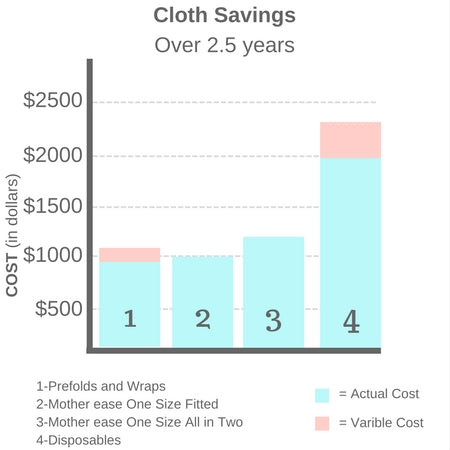
The Cloth Diapering Expert Series: Why Cloth Diapering?
The Cloth Diapering Expert Series: Why Cloth Diapering?
Why Cloth Diapering?

Welcome back to the Mother-ease Expert Series! In this installment, I will explain to you why cloth diapering is beneficial over disposable diapering. You will learn the pros and cons of both systems!
Today I'm answering the question, "Why Cloth Diapering?"
Cloth diapers have been growing in popularity recently, but it is in no way a new phenomenon. Chances are you don't know anyone that uses cloth, or maybe you do but they don't recommend them. I'm here to tell you that it's worth looking into. When you know what you're doing, understand why cloth is beneficial, and have the right system, I know you'll love it.
As I've said before, your baby is going to spend ALL of their time in diapers, which makes it no less important than buying their crib, stroller or car seat. With that in mind, it makes sense to spend some time doing research and carefully consider your decision.
There are three main benefits to using cloth diapers: cost savings, health, and environmental impact.
Cost Savings

Although the initial investment may seem high, your long-term savings are substantial. Disposable diapers seem to be constantly going up in price, only to be thrown away. These costs can reach upwards of $2,300 by the time your child is potty trained. Cloth diapers come with a one-time upfront cost of $500 to $700 plus $500 in laundering costs for a total of $1,000 to $1,200.
Cloth diapers can last from birth to potty training and also be used for your second child* if properly cared for. This eliminates the second start-up cost and saves you even more! Cloth diapers come in a variety of options, but no matter which style you choose, the cost of cloth diapers is significantly less than disposables.
Health
Have you ever considered what disposable diapers are made of? How did they get to be so white? How do they manage to absorb so much?
Disposable diapers are full of chemicals. Here is an overview of the harmful toxins in disposable diapers that your baby is exposed to:
Toxic Off Gases - Lab tests that were done by Anderson Laboratories in West Hartford, Vermont found that off-gases released by disposable diapers emit several chemicals that are toxic to the respiratory tract. The study states that disposable diapers should be considered as one of the factors that might cause or exacerbate asthmatic conditions.
Chlorine Gas and Chlorine Dioxide - Disposables are made mostly of soft, fluffy pulp which is produced by chemically treating wood fibers. The pulp undergoes a whitening and softening process when it is exposed to chlorine-based bleaching agents such as chlorine gas and chlorine dioxide.
Organochlorides - By-products produced and released into the environment during the manufacturing of disposable diapers. They are found in large quantities in wastewater released into the environment, and they remain in minute quantities in the paper fluff itself.
Dioxin - An organochloride that has been called the most toxic substance ever produced and has been associated with birth defects, miscarriage, cancer and genetic damage. This chemical remains in the paper fluff in minute quantities and no one knows exactly how much exposure to dioxin is required for disease to develop, however it is toxic in very small amounts.
Sodium Polyacrylate - This substance is found in the fluff layer of the disposable diaper and turns your baby's urine into gel. This chemical absorbs 100 times its weight in liquid and makes disposables very absorbent. This chemical has been linked to Toxic Shock Syndrome in tampon use and has been associated with severe diaper rash and bleeding perennial and scrotal tissue. This chemical pulls fluid so strongly it excoriates human tissue.
In contrast, a few dozen cloth diapers against your child's delicate skin compared to 5,000 disposables during one child's diapering years represent a safe and responsible alternative to your child's health.
Environmental Impact
It goes without saying, but disposable diapers are bad for the environment. When you choose disposables, you are spending your money contributing to landfills. And while it may seem like the amount of water and electricity used to care for cloth is also bad for the environment, the impact is minimal in comparison. Click here to read more about the environmental effects of cloth diapers vs. disposable diapers.
If you ask me, cloth diapering is a pretty clear winner between reusable systems and disposables. Still not sure yourself? Watch for the next installment of the Expert Series and find out just how easy cloth diapering can be! Afraid you might miss it? Click here to sign up to receive our blog notifications and have it sent straight to your inbox!
Next Issue: Cloth Diapers are Easier than you Think!
*Mother-ease recommends having a minimum of 24 diapers if using 100% Organic Cotton diapers to last for one child. There is no polyester core sewn into the Organic Cotton to add the durability, as there is in our Unbleached and Colored Cotton or Bamboo Terry diapers.
